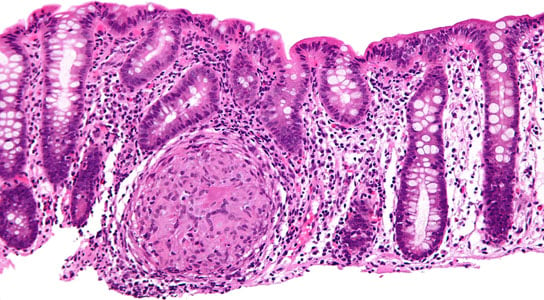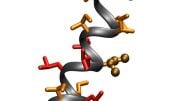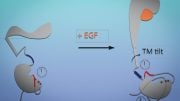
Endoscopic biopsy showing granulomatous inflammation of the colon in a case of Crohn’s disease. Credit: wikipedia/nephron
A new study from scientists at MIT gives a comprehensive look at how chronic inflammation of organs, often caused by viral or bacterial infections, provokes tissues into becoming cancerous. The research may lead to a better understanding of chronic inflammation and intervention methods to protect against it.
One of the biggest risk factors for liver, colon, or stomach cancer is chronic inflammation of those organs, often caused by viral or bacterial infections. A new study from MIT offers the most comprehensive look yet at how such infections provoke tissues into becoming cancerous.
The study, which is appearing in the online edition of Proceedings of the National Academy of Sciences the week of June 11, tracked a variety of genetic and chemical changes in the livers and colons of mice infected with Helicobacter hepaticus, a bacterium similar to Helicobacter pylori, which causes stomach ulcers and cancer in humans.
The findings could help researchers develop ways to predict the health consequences of chronic inflammation, and design drugs to halt such inflammation.
“If you understand the mechanism, then you can design interventions,” says Peter Dedon, an MIT professor of biological engineering. “For example, what if we develop ways to block or interrupt the toxic effects of the chronic inflammation?”
Dedon is one of four senior authors of the paper, along with Steven Tannenbaum, a professor of biological engineering and chemistry; James Fox, a professor of biological engineering and director of the Department of Comparative Medicine; and Gerald Wogan, a professor of biological engineering and chemistry. Lead author is Aswin Mangerich, a former MIT postdoc now at the University of Konstanz in Germany.
Too much of a good thing
For the past 30 years, Tannenbaum has led a group of MIT researchers dedicated to studying the link between chronic inflammation and cancer. Inflammation is the body’s normal reaction to any kind of infection or damage, but when it goes on for too long, tissues can be damaged.
When the body’s immune system detects pathogens or cell damage, it activates an influx of cells called macrophages and neutrophils. These cells’ job is to engulf bacteria, dead cells, and debris: proteins, nucleic acids, and other molecules released by dead or damaged cells. As part of this process, the cells produce highly reactive chemicals that help degrade the bacteria.
“In doing this, in engulfing the bacteria and dumping these reactive chemicals on them, the chemicals also diffuse out into the tissue, and that’s where the problem comes in,” Dedon says.
If sustained over a long period, that inflammation can eventually lead to cancer. A recent study published in the journal The Lancet found that infections account for about 16 percent of new cancer cases worldwide.
Widespread damage
In the new MIT study, the researchers analyzed mice that were infected with H. hepaticus, which causes them to develop a condition similar to inflammatory bowel disease in humans. Over the course of 20 weeks, the mice developed chronic infections of the liver and colon, with some of the mice developing colon cancer.
Throughout the 20-week period, the researchers measured about a dozen different types of damage to DNA, RNA, and proteins. They also examined tissue damage and measured which genes were turned on and off as the infection progressed. One of their key findings was that the liver and colon responded differently to infection.
In the colon, but not the liver, neutrophils secreted hypochlorous acid (also found in household bleach), which significantly damages proteins, DNA and RNA by adding a chlorine atom to them. The hypochlorous acid is meant to kill bacteria, but it also leaks into surrounding tissue and damages the epithelial cells of the colon.
The researchers found that levels of one of the chlorine-damage products in DNA and RNA, chlorocytosine, correlated well with the severity of the inflammation, which could allow them to predict the risk of chronic inflammation in patients with infections of the colon, liver or stomach. Tannenbaum recently identified another chlorine-damage product in proteins: chlorotyrosine, which correlates with inflammation. While these results point to an important role for neutrophils in inflammation and cancer, “we don’t know yet if we can predict the risk for cancer from these damaged molecules,” Dedon says.
Another difference the researchers found between the colon and the liver was that DNA repair systems became more active in the liver but less active in the colon, even though both were experiencing DNA damage. “It’s possible that we have kind of a double whammy [in the colon]. You have this bacterium that suppresses DNA repair, at the same time that you have all this DNA damage happening in the tissue as a result of the immune response to the bacterium,” Dedon says.
The researchers also identified several previously unknown types of damage to DNA in mice and humans, one of which involves oxidation of guanine, a building block of DNA, to two new products, spiroiminodihydantoin and guanidinohydanotoin.
James Swenberg, a professor of environmental sciences and engineering at the University of North Carolina School of Public Health, says the “comprehensive and innovative” study should help researchers better understand many types of cancer. “I can’t remember ever seeing a paper that brought so many aspects of research to the table in one report,” says Swenberg, who was not involved in the study.
In future studies, the MIT team plans to investigate the mechanisms of cancer development in more detail, including looking at why cells experience an increase in some types of DNA damage but not others.
Reference: “Infection-induced colitis in mice causes dynamic and tissue-specific changes in stress response and DNA damage leading to colon cancer” by Aswin Mangerich, Charles G. Knutson, Nicola M. Parry, Sureshkumar Muthupalani, Wenjie Ye, Erin Prestwich, Liang Cui, Jose L. McFaline, Melissa Mobley, Zhongming Ge, Koli Taghizadeh, John S. Wishnok, Gerald N. Wogan, James G. Fox, Steven R. Tannenbaum and Peter C. Dedon, 11 June 2012, Proceedings of the National Academy of Sciences.
DOI: 10.1073/pnas.1207829109
The research was funded by the National Cancer Institute.









Good Day Sir
I came across a website that speaks about chronic inflammation and cancer!
Please can i ask for your sincere advice as i have been suffering with a condition for many years now.
I am 37 years old male living in SA. Since I was 16 years old i have been having chronic inflammation of the joints, They just get inflamed for no reason what so ever. i am currently taking anti-inflammation pills for the condition, however that is not my biggest challenge !
I also have been having chronic inflammation of internal organs like stomach , colon , liver, etc . I am in alot of pain when this happens and i have been to the best doctors i could find, they cannot find any diseases, Blood tests are all clear and xrays dont show anything besides a little inflammation.
What can this be ? I am very depressed as doctors dont have a clue what is causing this inflammation of my organs.
Please can you let me know if you have come across such a disease and what can i do about it?
Thank You Kindly Sir
Devan
It’s been a very long time since this post but maybe I can provide some information on this health question asked by Devon.
I’ve learned alot thru my own health Odyssey and believe we should share our knowledge with others.
@Devon, do you still have these issues?